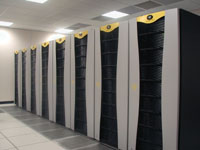| |||||||||||||||||||||||
| |||||||||||||||||||||||
|
|
Newton (SGI Altix 3700)The SGI Altix 3700 machine has been named Newton in honour of the English mathematician Sir Isaac Newton (1643-1727). Overview
Specifications
Configuration InformationNewton is now configured as a 512 processor single system image, running one copy of the Linux operating system, visible to the outside world as newton.cfs.ac.uk. This has only recently become possible due to advances in Linux scalability, some of which have involved changes to the open source Linux kernel and some of which have been included in SGI's Propack extensions. Six processors on the system have been set aside for operating system tasks (the boot cpuset) and another four are given over to interactive use (the service cpuset). The remaining 502 processors, 128 at 1.5GHz and 374 at 1.3GHz, should be available for batch work, hence this is the maximum job size of the machine. During core hours, the development queue will take up 16 of the 1.3GHz processors. Therefore since jobs over 358 processors will have to span the two types of processor, they will initially only be run by special request to csar-advice@cfs.ac.uk. Users must submit jobs to the newt15 queue (using the -q newt15 option to bsub) in order to run on the 1.5GHz processors. No job will run across both 1.3 GHz and 1.5GHz processors unless it is too large to be run without doing so. Note that X applications such as totalview can be used by jobs in the development queue provided the DISPLAY environment variable is set correctly in your batch script and you have allowed access to your local machine (i.e. your local firewall allows incoming X traffic and you have used the xhost command to give access permissions to newton). It is also possible to run X applications from your interactive ssh session provided that X forwarding is turned on at your local machine. Further Newton local configuration information is provided as follows: |
||||||||||||||||||||||
|
Page maintained by csar-advice@cfs.ac.uk This page last updated: Tuesday, 06-Sep-2005 12:15:02 BST |
|||||||||||||||||||||||

